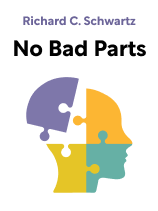

This article is an excerpt from the Shortform book guide to "No Bad Parts" by Richard C. Schwartz. Shortform has the world's best summaries and analyses of books you should be reading.
Like this article? Sign up for a free trial here.
What exactly is “unblending” in the IFS? What is the purpose of the unblending technique?
Unblending is a key concept in Richard Schwartz’s Internal Family Systems (IFS) model. The purpose of unblending is to unblend (that is, unfuse) your core Self from the parts that have taken over and reclaim control.
Keep reading to learn about IFS unblending and how to practice it.
What Is Unblending?
Before we can help our parts, we must be able to unblend from them. In our day-to-day lives, the Self is frequently overpowered by one or more of our parts—a phenomenon Schwartz calls “blending.” When a part and our Self are “blended,” the feelings and perspective of a burdened part merge with the Self. The compassion and patience of the Self becomes eclipsed by the needs, desires, and intentions of the part.
Blending is most common in moments of intense emotion. For example, if a parent criticizes a recent career choice, an exiled part searching for parental approval might feel deeply hurt, causing a protective part to step in as defense. When the protector blends with the Self, they may yell, criticize, or stonewall as a tool or protection.
(Shortform note: Schwartz’s discussion of blending focuses on the negative consequences of being blended with our parts. However, other IFS therapists clarify that blending is not necessarily good or bad. For example, when we need to organize a complex task, it makes sense to blend with a manager who is especially detail-oriented. The key is making sure we blend intentionally instead of reactively.)
We can practice IFS unblending by noticing when we’re embodying qualities of the Self and what it feels like to embody the Self. According to Schwartz, every person’s Self shares the same set of qualities, such as open heartedness and curiosity. Schwartz explains that when we’re Self-led, we often experience a feeling of spaciousness, and perhaps, most noticeably, an absence of internal voices of anxiety, self-doubt, and fear. Though nobody can be Self-led all the time, noticing when we’re embodying the Self and what it feels like to be Self-led will allow us to unblend more easily when we need access to the Self.
| Additional Strategies for Unblending If simply noticing when you’re embodying qualities of Self doesn’t work, certified IFS practitioner Michael Pasterski offers additional strategies that can be helpful when attempting to unblend from our parts. 1) Ask the part to step aside momentarily. 2) Picture the part, and then imagine yourself creating physical distance from that part. 3) Draw the part on paper to see it more clearly. 4) Do a short meditation to quiet internal conflicting voices. He recommends that if you’re still blended and a part is not willing to let the Self take over, try asking the part what it is afraid of. Understanding this fear will help the Self empathize and offer reassurance to the part. |

———End of Preview———
Like what you just read? Read the rest of the world's best book summary and analysis of Richard C. Schwartz's "No Bad Parts" at Shortform.
Here's what you'll find in our full No Bad Parts summary:
- A detailed look at IFS—a psychotherapy model that challenges the idea of a unitary mind
- Why it's normal to have conflicting voices in your head
- What IFS therapy looks like in practice and its benefits






